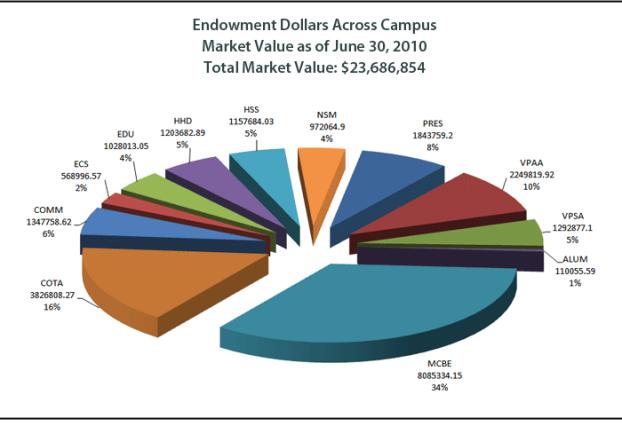 Caption: This chart illustrates the percentage and total market value of endowment funds secured for each college as well as various divisions on campus as of June 30, 2010. Graphic supplied by Ira Unterman
Caption: This chart illustrates the percentage and total market value of endowment funds secured for each college as well as various divisions on campus as of June 30, 2010. Graphic supplied by Ira Unterman
Improving Educational Opportunities
University Endowments Benefit Students and Programs
Scholarships. Research funding. New equipment. Program development.
All this — and more — is offered through more than 225 endowment funds at Cal State Fullerton, with more than half devoted to student scholarships. In fact, the total value of endowment gifts is rapidly approaching $25 million. This year’s earnings distribution will provide $683,315 for scholarships and programs across campus.
In the graph below, you can see how endowment funds are distributed across our campus as of June 30, 2010. All eight colleges are represented as are the offices of the President, Vice President of Academic Affairs, Vice President of Student Affairs and Alumni Affairs.
The endowment funds are managed by the Cal State Fullerton Philanthropic Foundation. Its board of governors, made up of alumni and community leaders, doesn’t decide what or where the money is to be spent – those decisions are made by the donors who make contributions to the university. However, the board is responsible for the investment and oversight of the funds and regularly reviews the results of their decisions.
“Our alumni and friends make these funds available to our university through their generosity. Once the earnings are distributed, most colleges or programs have faculty committees that determine how the earnings will be used,” said Ira Unterman, chief financial officer of the CSUF Philanthropic Foundation and executive director of advancement operations. “We do have a responsibility to see that the funds are directed to programs designated by the donors.”
Last September, the foundation adopted the guidelines established by the Uniform Prudent Management of Institutional Funds Act (drafted by the National Conference of Commissioners on Uniform State Laws). As a result, the foundation invests the endowment to ensure current needs with an eye toward the future. This year, the foundation will distribute three percent of earnings for current needs and set aside one percent as a reserve to help offset future increases in the costs of providing programs and services.
“For instance, an endowment created with a gift of $100,000 to pay for one course in biology can pay for that course today, but we want to make sure that we can still do so years from now despite the fact that the salary we pay the professor may increase, there may be additional expenses (technology, equipment) and the cost of providing that class continues to rise,” Unterman explained. “Establishing an inflation reserve is a standard practice among endowments.”
Most of the endowments are specific to colleges or programs so they must be used in those areas. That said, endowments are now written to ensure that they function in perpetuity.
“For example, we have one endowment that stipulated that the student receiving funding must be enrolled in a specific class,” Unterman explained. “If, for some reason, we drop that class or don’t offer it for a semester, that means the money can’t reach students. We now ask donors to give colleges and departments the opportunity to redirect the funds to other academic priorities within their area.”
In another example, a donor wanted the funding to be applied to the study of a specific endangered bird. The university wanted to meet their needs, so it stipulated funding would be directed to that cause. However, in the event that this was no longer possible, the campus would look at all endangered bird species, then ornithological studies. The goal is to remain true to the spirit of the donors’ intentions without limiting ourselves if a particular program ends.
Today, the minimum amount needed to create an endowment is $25,000 (previously it was $10,000). To fund a $1,000 scholarship, the foundation encourages a goal of $35,000 in the endowment account. University Advancement staff work with donors to create personalized gift agreements to ensure the donor’s intent matches the needs of the specific area of interest.
“For example, the Kimberly Perkins Award for Dedication to Academic Excellence was funded several years ago by Kimberly’s parents, Nanci and Rick,” said Unterman. “Their daughter, Kimberly, was a CSUF student who majored in child and adolescent studies. Sadly, she died of cancer at age 24 and her parents wanted to set up an endowment fund that would provide scholarships to students in child and adolescent studies.
“The goal, at that time, was to raise $10,000, but through family and friends, they ended up raising over $40,000,” he continued. “That means instead of students receiving a $500 award, they now receive a $1,000 scholarship. And the family continues to give to the endowment every year. It’s their way of remembering their daughter and her commitment to higher education.”
Small gifts, made by multiple donors, also can add up to significant endowments. The faculty/staff library endowment, created at the outset of the It’s Our University campaign in 1991, has received thousands of small gifts from university faculty and staff members through the years. Today, the endowment’s current market value is more than $72,000 and annual earnings are used by the library to provide resources to enhance the collection.
In a little less than seven years, Cal State Fullerton’s endowment fund has grown from $6 million to $25 million.
“We’ve seen, through the generosity of Cal State Fullerton’s donors and the community, that we are capable of growing these gifts and providing greater benefits to the university.”
More information about endowment funds is available at Cal State Fullerton's Philanthropic Foundation website.
Sept. 7, 2010
